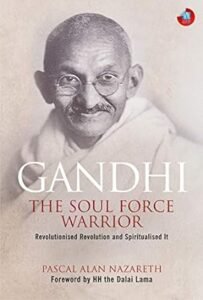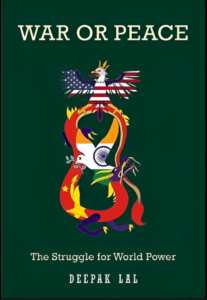
Review by:
Dr. A. K. Merchant
Gandhi: The Soul Force Warrior by P A Nazareth, IFS (retd.) Wisdom Tree 2019, 125pp,
Hardback. Ambassador is Nazareth founder of Sarvodaya International Trust.
I have always been inspired by the vision, mission, strategy and methodology of Mahatma Gandhi whenever I look back to the history of India’s independence. Ambassador Nazareth’s best seller Gandhi’s Outstanding Leadership Qualities translated into some 30 languages, made him a worldwide celebrity. This most recent work is even more engaging in the backdrop of the times our planet is passing through. Before, I proceed further let me quote briefly the author’s reasons for writing: Gandhi: The Soul Force Warrior, he says: “I admired the qualities, characters and beliefs of Mahatma Gandhi. The book deals with revolution and what will revolution do. As an apostle of truth, Gandhi promoted Truth and Non-Violence. We need to suffer and die for truth… [Gandhi] brought the age of European empires to its knees with a people-power revolution anchored in ‘truth’, ‘justice’, ‘love’ and ‘non-violence’. It contrasts sharply with prevailing means and mores of achieving desired objectives through tactics of fear, violence, torture, guns, drones, missiles and bombs. I want the younger generation to read this book and follow [his] ideals…”Cogently and effectively the book presents the viewpoint that Gandhi, the truth and soul-force warrior, had spiritualized revolution. Gandhi’s simplicity, originality and powerful techniques of truth and non-violence completely baffled the British rulers. For, they had no answer to his spiritual tactics. Mr. Nazareth presents both sides of this phenomenon with candour by giving the views of his critics, and those of his admirers and supporters, leaving it to the reader to decide which way the balance tilts. This book is a must-read for young minds in India. It unfolds the story of how a world where the struggle against injustice, oppression and violence against humans and Mother Earth is being waged, often against great odds. It will provide inspiration, encouragement and hope to all. Therefore, everyone interested in finding practical answers to present-day challenges in the lives of the individuals, the turmoil in the society and the various countries will not only be enlightened but find renewed inspiration to make a difference in their lives, the Gandhian Way! This highly readable book opens new vistas in our understanding of Gandhi, Gandhian thought and its contemporary relevance. In presenting Gandhi as a nonviolent revolutionary the author begins with a succinct survey of some of the theorists and practitioners of political revolution, especially in the 20th century, who probably without exception advocated achieving their goal through the use of violence. In contrast, Gandhi wrote in 1925: “However much I may sympathize with and admire worthy motives, I am an uncompromising opponent of violent methods even to serve the noblest of causes. Acts of violence create bitterness in the survivors and brutality in the destroyer”. Gandhi did believe in radical change but through following the path of Truth and Nonviolence. Settling in South Africa he found discrimination against the Indian population by the Europeans who, he discovered, were impervious to appeals to reason or justice. Thus he devised a new method of action which he called Satyagraha – the ‘Soul Force’ of the title. Much of the rest of his life consisted of experiments in satyagraha. Other important concepts in Gandhi’s thought – Swaraj, Sarvodaya, Swadeshi and Trusteeship are elucidated by the author. He touches on influences on Gandhi in addition to Hinduism such as Jainism, Buddhism, Islam, Jesus and Socrates. Gandhi lived in the time of imperialism and there was no greater colonial territory than India, therefore his influence in his homeland had repercussions elsewhere. But early in the 20th century there was considerable support for violent revolution especially in Bengal and Maharashtra and several British officials were assassinated. Later, in the 1930s Netaji Subhash Chandra Bose, a leading figure in the Indian National Congress, tried unsuccessfully to persuade Nazi Germany to collaborate but did succeed in raising an Indian National Army to fight with the Japanese against Britain. However, by 1920 Gandhi had won over the majority of Congress, the reformers and the more radical, to the use of satyagraha in their campaign for independence. He also turned Congress from an elite body into a mass membership organization. Independence was only one of Gandhi’s concerns and certain others were just as important – abolition of untouchability, the equality of women and men, abolition of poverty, the development of handicrafts, respect for nonhuman animals, respect for other religious and philosophical beliefs within a secular state, the creation of a nonviolent society – an immense task which was inevitably only partially successful. What about Gandhi’s legacy in the wider world? Ambassador Nazareth selects some cases where nonviolent direct action in the spirit of Gandhi have been successful: M L King and Civil Rights in the USA in the 1950s and 60s; Benigno and Corazon Aquino removing undemocratic government in the Philippines in the 1980s; Lech Walesa and Solidarity in Communist Poland in 1980s; in Chile after the Pinochet coup of 1973 nonviolent resistance continued through the 1980s including a Movement Against Torture led by a Jesuit Priest, Jose Aldunate, and all this led to the electoral defeat of Pinochet in 1990. In Burma, Aung San Suu Kyi showed great courage in leading the call for democracy. Sadly since entering government she has decided to give support to the military’s action against the Rohingya minority leading in 2017 to migration of more than half a million people to Bangladesh who are now living in a vast refugee camp. A successful example of nonviolent action, not however inspired by Gandhi, is described by the author. During the Nazi era about 2000 German Jews living in Berlin were rounded up with the intention of sending them to an extermination camp. However these men were married to German non-Jewish women who decided to protest outside the building, which was close to the Gestapo headquarters. For a week their chanting continued in spite of threats of shooting. On the eighth day Goebbels ordered the release of their husbands. This reviewer has made a study of nonviolent resistance within Nazi Germany and in the occupied territories and there are many more examples than is generally realized. Sometimes the resisters were inspired by Gandhi, more often by their own conscience. Looking to Gandhi’s contribution to India itself, the book points not just to the creation of the largest democracy in the world but to the manner of Britain leaving which was without rancour. Internally, Gandhi’s efforts, along with others, weakened the scourge of untouchability; the participation of women in the independence movement led to their heightened status; revival of rural industries; the indentured labour system which supplied British colonies with Indian workers was abolished in 1919. Gandhi always had his political opponents and his detractors and Mr. Nazareth mentions some–Churchill, the imperialist, B R Ambedkar the great Dalit leader, in spite of their aims of abolishing untouchability being the same, Subhash Chandra Bose and Veer Savarkar, the extreme nationalists, but he could have included the leading Muslim, M A Jinnah. However the list of his admirers is much longer– Albert Einstein, Nelson Mandela, Barack Obama, Pope Francis, the Dalai Lama and many more. The author uses quotations from such individuals as well as academics to build a portrait of one of the most remarkable individual to have lived in contemporary times – a revolutionary, and most importantly, a soul force warrior.

